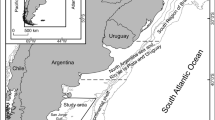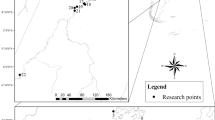Abstract
The high exploitation of marine fisheries resources for their economic value along with climate change in recent decades is threatening the regeneration of these resources. Available data on the state of fish stocks and the trophic organization and functioning of these aquatic environments are currently in insufficient. Considering this situation, we aim in this study to improve the knowledge and information available on the functioning of Mogador marine protected area (MPA), one of the marine ecosystems in the Moroccan Atlantic coasts which was established to support the conservation of the local fisheries. An Ecopath model is applied for this Mogador MPA which is represented by 27 functional groups including 18 fishes, which are grouped based on many criteria mainly their size and commercial importance in the fisheries of the study region. A series of indicator for the food web are identified through model statistics and web analysis. The results obtained show relatively high ecotrophic efficiency with a transfer efficiency close to10%, indicating a good degree of stability. Analysis of mixed trophic impact shows significant top-down control of the food web in this system. This study highlights the potential benefits of using an ecotrophic model to assess the effects of fishing on stocks.







Similar content being viewed by others
References
Belhabib, D., Mendy, A., Subah, Y., et al. (2015). Fisheries catch under-reporting in The Gambia, Liberia and Namibia and the three large marine ecosystems which they represent. Environment and Behaviour, 17, 157–174.
Christensen, V. (1995). Ecosystem maturity-towards quantification. Ecological Modelling, 77, 3–72.
Christensen, V., & Walters, C. (2004). Ecopath with Ecosim: Methods, capabilities and limitations. Ecological Modelling, 172, 109–139.
Christensen, V., Walters, C. J., & Pauly, D. (2005). Ecopath with Ecosim: A user’s guide: fisheries centre. University of British Columbia.
Coll, M., Akoglu, E., Arreguin-Sanchez, F., Fulton, A., Gascuel, D., Heymans, J. J., Libralato, S., Mackinson, S., Palomera, I., Piroddi, C., Shannon, L. J., Steenbeek, J., Villasante, S., & Christensen, V. (2015). Modellingdynamicecosystem: venturing beyond boundaries with the Ecopath approach. Reviews in Fish Biology and Fisheries, 25, 413–424.
Colleter, M., et al. (2013). An introduction to the EcoTroph R package: analyzing aquatic ecosystem trophic networks. The R Journal, 5, 98–107.
Colleter, M., Gascuel, D., Albouy, C., Francour, P., Tito de Maorais, L., Valls, A., & Le L’och, F. (2014). Fishing inside or outside? A case studies analysis of potential spillover effect from marine protected areas, using food web models. Journal of Marine Systems, 139, 383–395.
Colleter, M., Valls, A., Guitton, J., Gascuel, D., Pauly, D., & Christensen, V. (2015). Global overview of the applications of the Ecopath with Ecosim modeling approach using the EcoBase models repository. Ecological Modelling, 302, 42–53.
Département de la pêche Maritime (DPM)/Ministère de l’Agriculture, de la pêche Maritime, Royaume du Maroc. (2019). Rapport D’activité.
Essekhyr, H., Khalil, K., Damsiri, Z., Derhy, G., & Elkalay, K. (2019). Trophic interactions in the coastal ecosystem of Morocco: An Ecopath approach. Community Ecology, 20(2), 161–171.
FAO. (2011). Fisheries management 4. Marine protected areas and fisheries. FAO Technical Guidelines for Responsible Fisheries., 4(4), 198.
FAO. (2020). Report of the Working Group on the Assessment of Small Pelagic Fish of Northwest Africa Casablanca, Morocco, 8–13 July 2019. Fishery Committee for the Eastern Central Atlantic (CECAF). FAO Fisheries and Aquaculture Report No. 1309/FAO. Rome.
Finn, J. T. (1976). Measures of ecosystem structure and function derived from analysis of flows. Theoretical Biology, 56, 363–380.
Holling, C. S. (1973). Resilience and stability of ecological systems. Annual Review of Ecology and Systematics, 4, 1–23.
https://www.fishbase.se/trophiceco/trophicanalysis.php?ve_code=8&tag=1&ht=&ft=
Lassalle, G., Lobry, J., Le Loc’h, F., Bustamante, P., Certain, G., Delmas, D., Dupuy, C., Hily, C., Labry, C., Le Pape, O., & Marquis, E. (2011). Lower trophic levels and detrital biomass control the Bay of Biscay continental shelf food web: Implications for ecosystem management. Progress in Oceanography, 91, 561–575.
Libralato, S., Christensen, V., & Pauly, D. (2006). A method for identifying keystone species in food web models. Ecological Modelling, 195, 153–171.
Odum, E. P. (1969). The strategy of ecosystem development. Science Journal, 164(3877), 262–270.
Olmo Gilabert, R., Navia, A. F., La Gruz-Agüero, De., Molinero, J. C., Sommer, U., & Scotti, M. (2019). Body size and mobility explain species centralities in the gulf of California food web. Community Ecology, 20(2), 149–160.
Oumarous, M., Lakhnigue, A., Ben, M. A., Houssa, N., Charouki, N., Malouli, M., & Bekkali, M. (2016). Artisanal fishery of small pelagic: Diagnosis and prospects Case of Moroccan Atlantic center. International Journal of Advanced Research, 4(7), 1372–1386.
Pauly, D., Christensen, V., & Walters, C. (2000). Ecopath, Ecosim, and Ecospace as tools for evaluating ecosystem impact of fisheries. ICES Journal of Marine Science, 57, 697–706.
Power, E., Tilman, D., Estes, A., Menge, B., Bond, W., Scott, Mills L., Daily, G., Castilla, J. C., Lubchenco, J., & Paine, R. T. (1996). Challenges in the quest for keystones. Bioscience Journal, 46(8), 609–620.
Sommer, U., Charalampous, E., Sctotti, M., & Moustaka-Gouni, M. (2018). Big fish eat small fish: implications for food chain length? Community Ecology, 19(2), 107–115.
Stanford, R., Lunn, K., & Guénette, S. (2001). A preliminary ecosystem model for the Atlantic coast of morocco in the mid-1980s. Part III: Northeast Atlantic, p. 314.
Thiaw, M., Gascuel, D., Sadio, O., Ndour, I., Diadhiou, H. D., Kantoussan, J., Faye, S., Thiam, M., Meissa, B., & Brehmer, P. (2021). Efficiency of two contrasted marine protected areas (MPA) in West Africa over a decade of fishing closure. Ocean and Coastal Management, 210, 105655.
Ulanowicz, R. E. (1986). Growth and development: Ecosystems phenomenology (p. 203). Springer-Verlag.
Ulanowicz, R. E., & Puccia, C. J. (1990). Mixed trophic. Impacts in ecosystem. Coenoses, 5(1), 7–16.
Ullah, M. H., Rashed-Un-Nabi, M., & Al-Mamun, M. A. (2012). Trophic model of the coastal ecosystem of the Bay of Bengal using mass balance Ecopath model. Ecological Modelling, 225, 82–94.
Valls, A., Coll, M., & Christensen, V. (2015). Keystone species: toward an operational concept for marine biodiversity conservation. Ecological Monographs, 85(1), 29–47.
Author information
Authors and Affiliations
Corresponding author
Appendix
Appendix
See Table 3.
Rights and permissions
About this article
Cite this article
Damsiri, Z., Khalil, K., Ghoufrane, D. et al. An ecopath model for fisheries management in the Mogador marine protected area (Moroccan, Atlantic). COMMUNITY ECOLOGY 23, 13–26 (2022). https://doi.org/10.1007/s42974-021-00069-0
Received:
Accepted:
Published:
Issue Date:
DOI: https://doi.org/10.1007/s42974-021-00069-0




